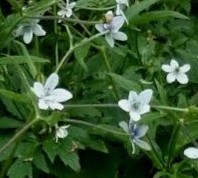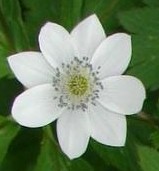 This herbaceous, clump-forming perennial is native to Kashmir, northern India, Tibet, and southwest China. It belongs to buttercup family, Ranunculaceae, that also includes delphinium, clematis, and hellebore. It grows up to 24″ tall and has dark green leaves that are deeply three-lobed. The flowers lack petals but have five pure white sepals tinged with blue on the reverse, and steel-blue anthers. Each flower is about an inch across, saucer-shaped, and borne on stiff a stem in clusters of three to five in summer. The genus name, Anemone, is probably a corrupted Greek loan word of Semitic origin referring to the lament for the slain Adonis or Naaman, whose scattered blood produced the blood-red Anemone coronaria. The specific epithet, rivularis, comes from the Latin word rivus meaning river or stream and refers to the fact that these plants like moist soil that never dries out.
This herbaceous, clump-forming perennial is native to Kashmir, northern India, Tibet, and southwest China. It belongs to buttercup family, Ranunculaceae, that also includes delphinium, clematis, and hellebore. It grows up to 24″ tall and has dark green leaves that are deeply three-lobed. The flowers lack petals but have five pure white sepals tinged with blue on the reverse, and steel-blue anthers. Each flower is about an inch across, saucer-shaped, and borne on stiff a stem in clusters of three to five in summer. The genus name, Anemone, is probably a corrupted Greek loan word of Semitic origin referring to the lament for the slain Adonis or Naaman, whose scattered blood produced the blood-red Anemone coronaria. The specific epithet, rivularis, comes from the Latin word rivus meaning river or stream and refers to the fact that these plants like moist soil that never dries out.
Type: Herbaceous perennial
 Bloom: White flowers with steel-blue stamens produced in clusters of three to five in summer.
Bloom: White flowers with steel-blue stamens produced in clusters of three to five in summer.
Size: 24” H x 12” W
Light: Dappled shade (tolerates more sun with adequate moisture)
Soil: Fertile, humus rich, moist, well-drained
Hardiness: Zones 6-8
Care: Water during times of drought; do not allow to dry out.; prune after flowering to encourage second flush.
Pests and Diseases: slugs, eelworms, caterpillars, powdery mildew
Propagation: Fresh seed; division in late summer t early fall
Companion plants: Northernmaidenhair fern (Adiantum pedatum), Sword fern (Polystichum munitum), hosta, Lenten rose (Helleborus orientalis), Tiarella cordifolia, Trilllium grandiflora, toad lily (Tricyrtis formosana).
